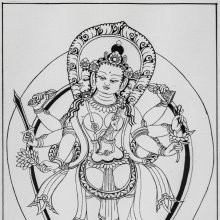Mahashila, Mahāśīla: 5 definitions
Introduction:
Mahashila means something in Hinduism, Sanskrit. If you want to know the exact meaning, history, etymology or English translation of this term then check out the descriptions on this page. Add your comment or reference to a book if you want to contribute to this summary article.
The Sanskrit term Mahāśīla can be transliterated into English as Mahasila or Mahashila, using the IAST transliteration scheme (?).
Images (photo gallery)
In Hinduism
Purana and Itihasa (epic history)
Source: Cologne Digital Sanskrit Dictionaries: The Purana IndexMahāśīla (महाशील).—A son of Janamejaya and father of Mahāmanas.*
- * Bhāgavata-purāṇa IX. 23. 2.

The Purana (पुराण, purāṇas) refers to Sanskrit literature preserving ancient India’s vast cultural history, including historical legends, religious ceremonies, various arts and sciences. The eighteen mahapuranas total over 400,000 shlokas (metrical couplets) and date to at least several centuries BCE.
Ayurveda (science of life)
Source: Research Gate: On Fish in Manasollasa (c. 1131 AD)Mahāśīla (महाशील) refers to a type of fish identified with Tor tor Ham., as mentioned in the 12th-century Mānasollāsa or Abhilaṣitārthachintāmaṇi, an ancient Sanskrit text describing thirty-five kinds of marine and fresh water fishes.—Someshvardeva mentions Mahashila to be a riverine, scaly, large fish. Mahashila in Sanskrit could mean a large stone-like (powerful) fish. This name is very similar to the famous mahaseer fish (Tor tor Ham.) of India. Hora (1951) suggested that mahashila could be South Indian Barbus (Tor) mussulah Sykes or B. (Tor) khudree Sykes. Barbus khudree is not a large fish. Hora (1951) did not consider Tor tor because it is present in northern India. We find that Day (Watt, 1890) mentions the presence of T. tor all over India. We, therefore, suggest that mahashila is T. tor, a barb.

Āyurveda (आयुर्वेद, ayurveda) is a branch of Indian science dealing with medicine, herbalism, taxology, anatomy, surgery, alchemy and related topics. Traditional practice of Āyurveda in ancient India dates back to at least the first millenium BC. Literature is commonly written in Sanskrit using various poetic metres.
Languages of India and abroad
Sanskrit dictionary
Source: Cologne Digital Sanskrit Dictionaries: Monier-Williams Sanskrit-English Dictionary1) Mahāśilā (महाशिला):—[=mahā-śilā] [from mahā > mah] f. a kind of weapon (a Śata-ghnī with iron nails), [cf. Lexicographers, esp. such as amarasiṃha, halāyudha, hemacandra, etc.]
2) Mahāśīla (महाशील):—[=mahā-śīla] [from mahā > mah] m. Name of a son of Janam-ejaya, [Bhāgavata-purāṇa] (cf. -śāla).
[Sanskrit to German]
Sanskrit, also spelled संस्कृतम् (saṃskṛtam), is an ancient language of India commonly seen as the grandmother of the Indo-European language family (even English!). Closely allied with Prakrit and Pali, Sanskrit is more exhaustive in both grammar and terms and has the most extensive collection of literature in the world, greatly surpassing its sister-languages Greek and Latin.
See also (Relevant definitions)
Partial matches: Shila, Maha, Cila.
Starts with: Mahashilakantaka.
Full-text: Mahamani, Mahashilakantaka, Udagra.
Relevant text
Search found 4 books and stories containing Mahashila, Maha-shila, Mahā-śilā, Maha-sila, Mahā-śīla, Mahāśīla, Mahasila, Mahāśilā; (plurals include: Mahashilas, shilas, śilās, silas, śīlas, Mahāśīlas, Mahasilas, Mahāśilās). You can also click to the full overview containing English textual excerpts. Below are direct links for the most relevant articles:
The Bhagavata Purana (by G. V. Tagare)
Chapter 23 - The History of the Dynasties of Anu, Druhyu, Turvasu and Yadu < [Book 9 - Ninth Skandha]
The Vishnu Purana (by Horace Hayman Wilson)
Bhagavati-sutra (Viyaha-pannatti) (by K. C. Lalwani)
Part 2 - Account of Mahāśilākaṇṭaka battle < [Chapter 9]
Trishashti Shalaka Purusha Caritra (by Helen M. Johnson)
Part 7: War between Kūṇika and Ceṭaka < [Chapter XII - Omniscience and wandering of Mahāvīra]
